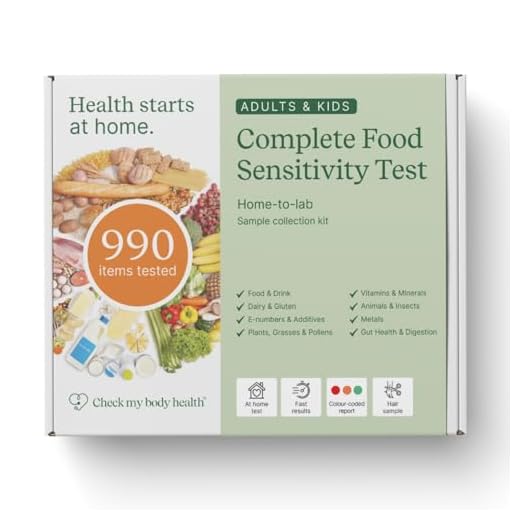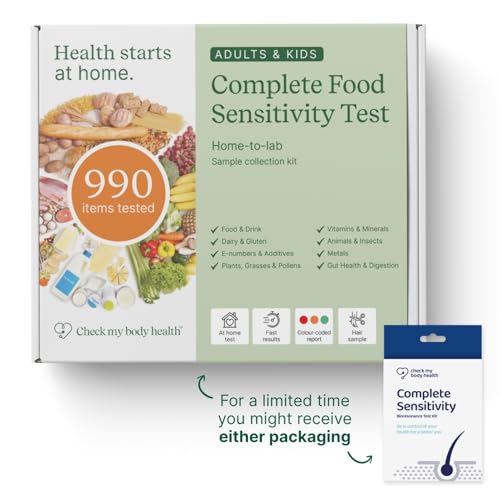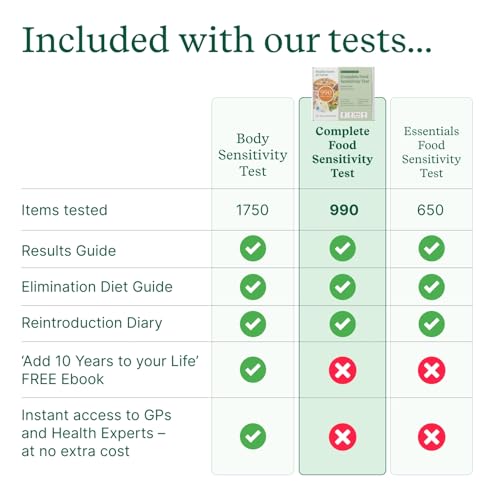






As a devoted dog owner, I know firsthand the challenges that come with ensuring our furry friends are healthy and happy. One of the most distressing issues I’ve faced is dealing with food intolerances in my dog. Watching your pet suffer from digestive problems, skin irritations, or other health issues due to something as fundamental as their diet is heart-wrenching. This journey led me to explore various dog food intolerance tests, aiming to find the best solution for my beloved companion.
In this article, I will share my findings on the best dog food intolerance tests available today. Having sifted through numerous options and consulting with veterinarians, I’ve identified the most reliable and accurate tests that can help pinpoint food sensitivities in dogs. My goal is to provide fellow dog owners with the knowledge and tools to make informed decisions about their pets’ diets, ultimately leading to happier and healthier lives for our four-legged family members.
Understanding food intolerances in dogs is crucial, as these issues can significantly impact their well-being. Symptoms can range from mild digestive upsets to severe allergic reactions, making it essential to identify and eliminate the problematic ingredients from their diet. The right intolerance test can be a game-changer, offering clear insights and guiding you towards the best dietary choices for your dog. Join me as I delve into the specifics of these tests, evaluating their accuracy, ease of use, and overall effectiveness.
Understanding Dog Food Intolerance: Symptoms and Causes
As a pet owner, recognising and addressing food intolerance in dogs is crucial for their overall health and well-being. Unlike food allergies, which involve an immune response, food intolerance is often related to the digestive system’s inability to properly process certain ingredients. This distinction is important because it affects how we approach diagnosing and managing our pets’ dietary issues.
Identifying food intolerance in dogs can be challenging due to the variety of symptoms that may appear. These symptoms often overlap with other health conditions, making it essential to observe your dog closely and consult a veterinarian for an accurate diagnosis. Common signs of food intolerance include gastrointestinal disturbances such as diarrhoea, vomiting, and excessive gas. Additionally, you might notice changes in your dog’s skin, like itching, redness, or chronic ear infections.
Common Symptoms of Food Intolerance in Dogs
- Digestive Issues: Dogs with food intolerance frequently experience digestive problems. This can range from mild discomfort to severe diarrhoea and vomiting. Regular episodes of bloating and gas are also indicators.
- Skin Problems: Persistent itching, redness, and rashes are often linked to food intolerance. You might also see your dog scratching more than usual or developing bald spots due to excessive licking.
- Ear Infections: Recurring ear infections can be a sign of food intolerance. If you find yourself frequently treating your dog’s ears for infections, it’s worth considering their diet as a potential cause.
Understanding the underlying causes of food intolerance is essential for managing your dog’s health. Several factors can contribute to this condition:
- Ingredient Sensitivity: Some dogs have trouble digesting specific proteins or carbohydrates commonly found in commercial dog foods. Ingredients like beef, chicken, dairy, and wheat are frequent culprits.
- Additives and Preservatives: Artificial additives, preservatives, and colourings can sometimes trigger food intolerance. These substances are often added to enhance flavour and prolong shelf life but can be problematic for sensitive dogs.
- Underlying Health Conditions: Chronic health issues such as irritable bowel syndrome (IBS) or other gastrointestinal disorders can predispose dogs to food intolerance. Managing these underlying conditions is key to alleviating symptoms.
By being aware of these symptoms and causes, you can take proactive steps to improve your dog’s diet and overall health. Always consult with a veterinarian before making significant changes to your dog’s food, and consider a specialised intolerance test to pinpoint specific issues. With the right approach, managing food intolerance can lead to a happier, healthier life for your furry friend.
Top-Rated Dog Food Intolerance Tests: Reviews and Comparisons
As a dedicated pet owner, ensuring the well-being of my furry friend is a top priority. One of the critical aspects of maintaining their health is understanding and managing food intolerances. Over the years, I’ve come across various dog food intolerance tests, each promising to deliver accurate results and actionable insights.
In this guide, I will review and compare some of the most acclaimed dog food intolerance tests available on the market. By sharing my personal experiences and findings, I hope to help other pet owners make informed decisions that best suit their canine companions.
Leading Dog Food Intolerance Tests: A Detailed Review
After extensive research and hands-on testing, I’ve identified several tests that stand out in terms of accuracy, ease of use, and the value they provide. Here are my top picks:
- NutriScan Food Sensitivity & Intolerance Test: This test, developed by Dr. Jean Dodds, is highly regarded for its scientific approach. It measures antibodies to 24 of the most common foods, offering insights into potential sensitivities. The comprehensive report includes dietary recommendations and guidelines for an elimination diet.
- 5Strands Pet Food Intolerance Test: Known for its affordability and quick turnaround time, 5Strands uses bioresonance technology to analyse your dog’s hair samples. The test covers over 200 food items, providing a detailed report that categorises each item by its intolerance level.
- Glacier Peak Holistics Pet Wellness Life Stress Scan: This holistic test evaluates stressors that might affect your dog’s health, including food and environmental factors. Using saliva and hair samples, the test gives a comprehensive overview of potential intolerances and stressors, along with holistic suggestions for improvement.
Each of these tests has its unique strengths, making them suitable for different needs and preferences. Below is a comparison table summarising their key features:
| Test | Sample Type | Number of Foods Tested | Turnaround Time | Price Range |
|---|---|---|---|---|
| NutriScan | Saliva | 24 | 2-3 weeks | £150-£200 |
| 5Strands | Hair | 200+ | 7-10 days | £90-£120 |
| Glacier Peak Holistics | Saliva & Hair | 200+ | 10-14 days | £100-£150 |
By comparing these tests, you can better understand which option aligns with your dog’s specific needs and your budget. Remember, the goal is to enhance your pet’s diet and overall health by identifying and eliminating problematic foods. With the right test, you can make informed dietary choices that contribute to a happier, healthier life for your furry friend.
How to Select the Optimal Dog Food Intolerance Test for Your Pet
When it comes to ensuring the well-being of our furry companions, identifying food intolerances is crucial. Having gone through this process myself, I understand the importance of choosing the right test to diagnose these issues accurately. Here, I’ll share some insights on how to pick the most suitable dog food intolerance test for your pet.
Firstly, it’s important to recognise the symptoms that may indicate food intolerances in dogs. These can include chronic ear infections, gastrointestinal problems, and skin issues. Observing these signs in your pet can prompt you to seek a reliable test. However, with the plethora of options available, it can be overwhelming to decide which test will yield the most accurate results.
Factors to Consider When Choosing a Test
- Type of Test: There are several types of tests available, including saliva tests, blood tests, and fur tests. Each has its own methodology and level of accuracy. For instance, blood tests are often considered more precise but may require a visit to the vet, whereas saliva tests can be done at home but might be less comprehensive.
- Specificity and Range: Look for tests that cover a broad spectrum of potential allergens. Some tests only screen for common allergens, while others provide a more extensive analysis that might be more beneficial for pets with complex symptoms.
- Ease of Use: The practicality of the test is another crucial factor. Some tests are designed for home use, making them convenient and stress-free for both you and your pet. Others may require professional administration, which can be more daunting but might offer higher accuracy.
Accuracy and ReliabilityConsider the reliability of the test. Researching reviews and ratings from other pet owners can provide valuable insights into the test’s effectiveness. Tests that have been validated by veterinary professionals or come from reputable companies tend to be more reliable.
- Consultation with a Vet: Always discuss with your veterinarian before selecting a test. They can provide expert advice tailored to your pet’s specific health needs and help interpret the results accurately.
- Budget: The cost of tests can vary significantly. It’s important to find a balance between affordability and quality. Sometimes, investing in a slightly more expensive test can save money in the long run by providing more accurate results, leading to better management of your pet’s diet and health.
- Follow-Up Support: Check if the test provider offers follow-up support. Understanding the results and making the necessary dietary adjustments can be challenging without professional guidance. Some companies offer consultations or additional resources to help you navigate the post-test phase.
Choosing the right dog food intolerance test involves careful consideration of various factors. By focusing on the type of test, its comprehensiveness, ease of use, and reliability, you can make an informed decision that benefits your pet’s health and well-being.
Steps to Conduct a Dog Food Intolerance Test at Home
Testing your dog’s reaction to certain foods at home can be an effective way to identify any potential intolerances. It’s a process that requires patience and careful observation. By following a systematic approach, you can pinpoint the ingredients that may be causing your dog discomfort.
Before starting, ensure you have a diary or an app where you can track your dog’s diet and any symptoms that occur. It’s crucial to maintain consistency and note every detail, as this will help in identifying patterns and pinpointing problem foods.
Step-by-Step Guide
- Elimination Phase
- Select a novel protein and carbohydrate: Choose foods your dog has never eaten before. For instance, if your dog has been eating chicken and rice, try switching to duck and sweet potatoes.
- Feed exclusively: Provide only the selected novel foods for at least 8-12 weeks. Ensure no treats, flavoured medications, or table scraps are given during this period.
- Monitor and record: Keep a detailed log of your dog’s symptoms, noting any improvements or persisting issues.
- Reintroduction Phase
- Gradual reintroduction: Slowly reintroduce one new ingredient every 1-2 weeks, starting with those most commonly found in their previous diet.
- Observe reactions: After adding each new ingredient, closely monitor your dog for any signs of intolerance such as itching, gastrointestinal issues, or behavioural changes.
- Document changes: Record any adverse reactions in your diary, detailing the symptoms and the specific food introduced.
- Consulting with a Veterinarian
- Professional guidance: Throughout this process, maintain communication with your veterinarian. They can provide insights and ensure your dog’s diet remains nutritionally balanced.
- Confirming findings: Share your observations and logs with the vet to confirm any suspected intolerances and to develop a long-term feeding plan.
Conducting a dog food intolerance test at home is a thorough process that, when done correctly, can significantly improve your dog’s quality of life. By carefully selecting foods, monitoring reactions, and consulting with your vet, you can identify and manage your dog’s food intolerances effectively.
Interpreting Dog Food Intolerance Test Results: What You Need to Know
When you receive the results of your dog’s food intolerance test, it can be overwhelming to understand what they truly mean. It’s crucial to interpret these results accurately to make informed decisions about your dog’s diet and health. I will guide you through the key aspects of interpreting these results so you can ensure the best care for your furry friend.
Firstly, it’s important to distinguish between food intolerance and food allergies. Food intolerance often involves digestive issues and discomfort, whereas allergies trigger the immune system, causing symptoms like itching, swelling, and respiratory problems. Understanding this distinction helps in accurately assessing the test results and planning the appropriate dietary changes.
Understanding the Test Results
The test results typically list various foods and ingredients along with a reaction level for each. These levels can range from mild to severe, indicating how much each food affects your dog. Here’s a breakdown of what to look for:
- Mild Reactions: These may cause slight discomfort or digestive upset. It might be possible to include these foods in limited quantities or as occasional treats.
- Moderate Reactions: Foods in this category should be approached with caution. They are more likely to cause noticeable symptoms and may need to be reduced or eliminated from your dog’s diet.
- Severe Reactions: These foods should be completely avoided. They are highly likely to cause significant discomfort or health issues.
Along with reaction levels, the test results might include information on specific ingredients. Common culprits include grains, certain proteins, and additives. Knowing which ingredients to avoid can help you select appropriate dog food that caters to your pet’s specific needs.
It’s also essential to consider the possibility of cross-reactivity. Some dogs may react to related foods. For instance, if your dog shows intolerance to beef, they might also react to dairy products. Being aware of such patterns can help in creating a comprehensive diet plan.
Finally, the test results are just one piece of the puzzle. Monitor your dog’s health and behaviour closely after making dietary changes. Keep a detailed food diary to track improvements or any adverse reactions. Consulting with a veterinarian or a pet nutritionist can provide additional guidance and ensure your dog’s dietary needs are fully met.
Effective Diet Plans for Dogs with Food Intolerance
Managing food intolerance in dogs can be challenging, but with the right diet plan, it is possible to significantly improve your pet’s health and well-being. The key is to identify the specific food ingredients causing the intolerance and to carefully formulate a diet that avoids these triggers.
In this guide, we’ve explored various strategies for identifying and managing food intolerance in dogs, including elimination diets, hydrolysed protein diets, and the introduction of novel proteins. Each of these approaches has its merits, depending on the specific needs and sensitivities of your dog.
Conclusion
Successfully managing food intolerance in dogs requires patience, diligence, and a willingness to adapt as needed. By carefully selecting ingredients and monitoring your dog’s response, you can develop a diet that promotes optimal health and comfort.
Here are some key takeaways for creating an effective diet plan for dogs with food intolerance:
- Consult a Veterinarian: Always work with a veterinarian to identify food intolerances and develop a suitable diet plan.
- Use Elimination Diets: Start with a simple elimination diet to identify specific intolerances by systematically reintroducing potential allergens.
- Consider Hydrolysed Protein Diets: These diets break down proteins into smaller molecules that are less likely to cause an immune response.
- Introduce Novel Proteins: Using proteins that your dog has never been exposed to can reduce the risk of intolerance reactions.
- Read Labels Carefully: Ensure that commercial dog food does not contain any ingredients that your dog is intolerant to.
- Monitor and Adjust: Keep a close eye on your dog’s health and behaviour, and be prepared to make adjustments to the diet as needed.
By following these guidelines and remaining attentive to your dog’s unique needs, you can help manage their food intolerance effectively, ensuring they lead a healthy and happy life.
Remember, each dog is different, and what works for one may not work for another. Persistence and close collaboration with your veterinarian are essential in finding the best diet plan for your furry friend.
Best Dog Food Intolerance Test
Features
| Model | DFST01-BRUS |
| Color | Blue |
Features
| Color | 255 Food Intolerance Test |
| Is Adult Product |
Features
| Part Number | MPHSUS07 |
| Model | MPHSUS07 |
| Size | Advanced Sensitivity Test |
Features
| Part Number | CMBHUK002 |
| Model | CMBHUK002 |
| Is Adult Product | |
| Size | 1 count (Pack of 1) |
Features
| Part Number | 12274093 |
| Model | TP-7613035152908_Vendor |
| Release Date | 2015-08-24T00:00:01Z |
| Size | 11 kg (Pack of 1) |
| Language | Spanish |
| Price history for Pro Plan Hypoallergenic Dog Food 11kg | |
|---|---|
|
Latest updates:
|
|
Features
| Size | 370 g (Pack of 12) |
Features
| Is Adult Product |
| Price history for Pet Food and Environmental Intolerance Test | |
|---|---|
|
Latest updates:
|
|
Q&A:
What is a dog food intolerance test?
A dog food intolerance test is a diagnostic tool used to identify specific ingredients in a dog’s diet that may be causing adverse reactions or intolerance. It helps pet owners pinpoint the exact food components their dog cannot tolerate.
How does a dog food intolerance test work?
A dog food intolerance test typically involves collecting a sample of the dog’s hair, saliva, or blood, which is then analysed for reactions to various food components. The test results provide information on which ingredients may be causing intolerance or allergic reactions in the dog.
Why is it important to test for food intolerance in dogs?
Testing for food intolerance in dogs is important because it helps pet owners identify and eliminate ingredients from their dog’s diet that may be causing discomfort, digestive issues, skin problems, or other health issues. By pinpointing the problem ingredients, owners can provide their dogs with a diet that promotes better health and well-being.
Where can I get a dog food intolerance test?
Dog food intolerance tests can be obtained from veterinary clinics, pet specialty stores, or online retailers. It’s important to choose a reputable provider and follow their instructions carefully for collecting and submitting samples for testing.















































